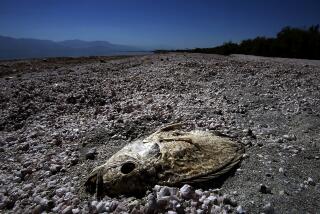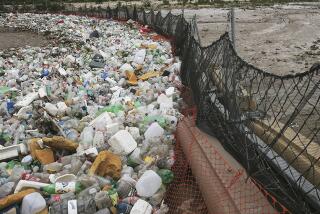We Can’t Afford to Ignore the Ocean’s Warning Signs
While San Diego continues its 17-year battle against the sewage-treatment requirements of the federal Clean Water Act, two small North County sewage plants may be getting a glimpse of future ocean water-quality problems.
State biologists say they have evidence that effluent from the Oceanside and Encina plants is contaminating commercially raised mussels in Agua Hedionda Lagoon. The plant operators are skeptical. They blame bird droppings and runoff from the land. But the state biologists say they have seen the pattern before, in the Santa Barbara Channel and in Morro Bay.
Encina and Oceanside already use the secondary-treatment processes that San Diego is still fighting. But biologists think that fecal coliform bacteria, which are used as indicators of disease-causing viruses and bacteria, are surviving those processes and being washed with the tides back into the lagoon--and the mussel beds--rather than being dispersed and killed off in the ocean. If the biologists’ suspicions prove true, the plants could be required to disinfect their waste water before dumping it into the ocean, a requirement that the plant operators would like to avoid because of the cost.
Seafarms West, the only commercial mussel grower in San Diego County, is understandably distressed. The increasing bacteria levels being found in its shellfish mean the mussels must be disinfected before being sold. San Diegans should be concerned. One of the reasons that Seafarms West is the only local grower is that many other possible sites are too contaminated by sewage.
Thus far, the dumping of treated waste water into the ocean has not been proven to be a health hazard for swimmers. And there are rigorous standards designed to keep contaminated shellfish off the market.
But, as San Diego County grows, and dumps ever-increasing amounts of treated sewage into the ocean, health and water-quality officials must be alert to any possible sign of trouble. The state study is just that. If the biologists are correct, it could mean that assumptions about the life span of bacteria and how well the effluent is dispersed need to be reexamined.
As the San Diego City Council knows all too well from its legal battles over the safety of treatment at the Point Loma plant, scientists disagree about the ocean’s capacity to absorb human waste, as well as the amount of treatment needed to protect water quality. What’s causing the mussel contamination in Agua Hedionda Lagoon is just a small piece of that larger puzzle.
State biologists hope to find the piece. But they need the cooperation of the treatment plant operators plus the state Regional Water Quality Control Board. The adversarial process that took place in Santa Barbara and Morro Bay should not be repeated here.
If the sewage plants are causing all or part of the mussel contamination, then corrective steps should be taken. If the study finds that they are not, then the question of paying for disinfection is moot.
San Diegans cannot afford a defensive posture if we hope to continue depending on the ocean for recreation and food as well as for cleansing our wastes.
More to Read
Sign up for Essential California
The most important California stories and recommendations in your inbox every morning.
You may occasionally receive promotional content from the Los Angeles Times.










